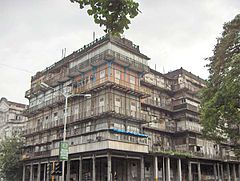Watson's Hotel
| Watson's Hotel | |
|---|---|

Watson's hotel, now known as Esplanade Mansions at Kala Ghoda
|
|
|
Location within Mumbai
|
|
| General information | |
| Town or city | Mumbai |
| Country | India |
| Coordinates | 18°55′42″N 72°49′52″E / 18.9283°N 72.8311°E |
| Construction started | 1867 |
| Completed | 1869 |
| Client | John Watson |
| Technical details | |
| Structural system | Cast iron |
| Design and construction | |
| Architect | Rowland Mason Ordish |
| Engineer | Rowland Mason Ordish |
Watson's Hotel (actually Watson's Esplanade Hotel), now known as the Esplanade Mansion, is India's oldest surviving cast iron building. It is located in the Kala Ghoda area of Mumbai (Bombay). Named after its original owner, John Watson, the building was fabricated in England and constructed on site between 1860 and 1863.
The hotel was leased on 26 August 1867 for the terms of 999 years at yearly rent of Rupees 92 and 12 annas to Abdul Haq. It was closed in the 1960s and was later subdivided and partitioned into smaller cubicles that were let out on rent as homes and offices. Neglect of the building has resulted in decay and, despite its listing as a Grade II–A heritage structure, the building is now in a dilapidated state.
Watson's hotel was designed by the civil engineer Rowland Mason Ordish, who was also associated with the St Pancras Station in London. The building was fabricated in England from cast iron components and was assembled and constructed on site. The external cast-iron frame closely resembles other high-profile 19th century buildings such as London's Crystal Palace. The main façade of the hotel is distinguished by building wide open balconies on each floor that connected the guest rooms, which were built around the atrium in a courtyard arrangement.
John Hudson Watson was born in 1818 in Castle Carrock, England to a farming family. He ran a successful drapery business in Bombay. His original plan for the building was to use it as additional office and showroom for his thriving drapery and tailoring businesses nearby. started to begin to ship pre-fabricated cast iron components from England as early as October 1865. The hotel was built between 1867 and 1869. The original design, as displayed on the painting in the Watson Institute, included plans for traditional European mansard roof, however it was never built.
John Watson opened the hotel as an exclusive whites-only hotel, and it one of the most renowned hotels in the city in those days. Then it was handed over to Hannah Maria Watson, by then the Secretary of State for India, wherein she entered into a lease deed with Sardar Abdul Haq,Diler ul Mulk,Diler ul Daula, for a term of nine hundred and ninety nine years on 26 August 1867. Later on, another indenture was made on the date 22-12-1885, between the trustees of Port Trust of Bombay and Sardar Diler ul Mulk in which land on the Wellington Reclamation Estate in island of Bombay admeasurment of 8129 sq.yrds. was leased by the Sardar Abdul Haq for a term of fifty years from 01-01-1880. The five-storied structure housed 130 guest rooms, as well as a lobby, restaurant and a bar at the ground level. The hotel also had a 30 by 9 metres (98 ft × 30 ft) atrium, originally used as a ballroom, with a glass skylight. At its peak, Watson's hotel employed English waitresses in its restaurant and ballroom, inspiring a common joke at the time: "If only Watson had imported the English weather as well."
...
Wikipedia

